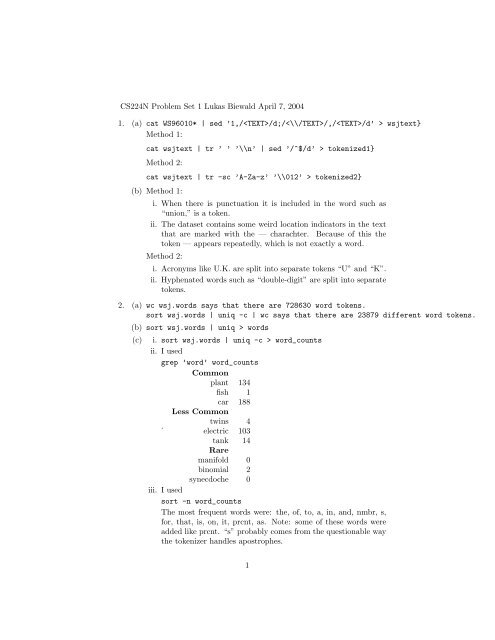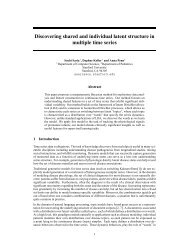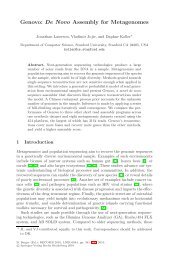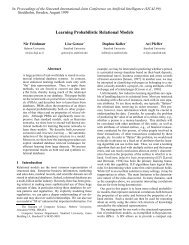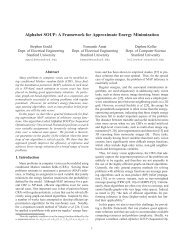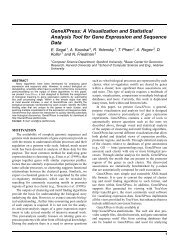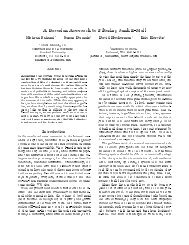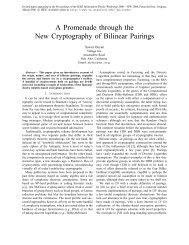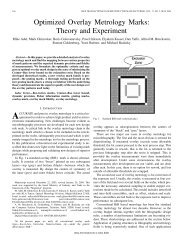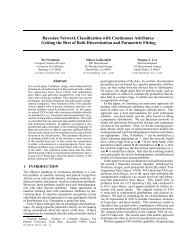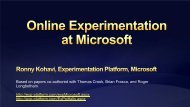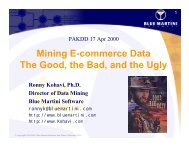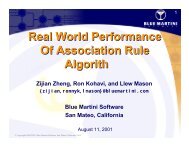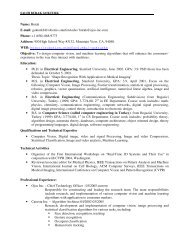CS224N Problem Set 1 Lukas Biewald April 7 ... - Stanford AI Lab
CS224N Problem Set 1 Lukas Biewald April 7 ... - Stanford AI Lab
CS224N Problem Set 1 Lukas Biewald April 7 ... - Stanford AI Lab
Create successful ePaper yourself
Turn your PDF publications into a flip-book with our unique Google optimized e-Paper software.
<strong>CS224N</strong> <strong>Problem</strong> <strong>Set</strong> 1 <strong>Lukas</strong> <strong>Biewald</strong> <strong>April</strong> 7, 2004<br />
1. (a) cat WS96010* | sed ’1,//d;//,//d’ > wsjtext}<br />
Method 1:<br />
cat wsjtext | tr ’ ’ ’\\n’ | sed ’/^$/d’ > tokenized1}<br />
Method 2:<br />
cat wsjtext | tr -sc ’A-Za-z’ ’\\012’ > tokenized2}<br />
(b) Method 1:<br />
i. When there is punctuation it is included in the word such as<br />
“union,” is a token.<br />
ii. The dataset contains some weird location indicators in the text<br />
that are marked with the — charachter. Because of this the<br />
token — appears repeatedly, which is not exactly a word.<br />
Method 2:<br />
i. Acronyms like U.K. are split into separate tokens “U” and “K”.<br />
ii. Hyphenated words such as “double-digit” are split into separate<br />
tokens.<br />
2. (a) wc wsj.words says that there are 728630 word tokens.<br />
sort wsj.words | uniq -c | wc says that there are 23879 different word tokens.<br />
(b) sort wsj.words | uniq > words<br />
(c) i. sort wsj.words | uniq -c > word_counts<br />
ii. I used<br />
grep ’word’ word_counts<br />
Common<br />
plant 134<br />
fish 1<br />
car<br />
Less Common<br />
188<br />
.<br />
twins<br />
electric<br />
4<br />
103<br />
tank<br />
Rare<br />
14<br />
manifold 0<br />
binomial 2<br />
synecdoche 0<br />
iii. I used<br />
sort -n word_counts<br />
The most frequent words were: the, of, to, a, in, and, nmbr, s,<br />
for, that, is, on, it, prcnt, as. Note: some of these words were<br />
added like prcnt. “s” probably comes from the questionable way<br />
the tokenizer handles apostrophes.<br />
1
iv. tail +2 wsj.words > wsj.nextwords<br />
tail +3 wsj.words > wsj.thirdwords}<br />
paste wsj.words wsj.nextwords > bigrams<br />
paste wsj.words wsj.nextwords wsj.thirdwords > trigrams<br />
sort bigrams | uniq -c | sort -n<br />
sort trigrams | uniq -c | sort -n<br />
Most common bigrams:<br />
the company<br />
to the<br />
on the<br />
in nmbr<br />
u s<br />
nmbr nmbr<br />
for the<br />
dllr million<br />
in the<br />
of the<br />
Most common trigrams:<br />
of the year<br />
the dow jones<br />
in new york<br />
dllr billion in<br />
nmbr to nmbr<br />
the end of<br />
one of the<br />
dllr million in<br />
nmbr nmbr nmbr<br />
the u s<br />
3. (a) cut -f1 word_counts | sort -nr | nl > freq<br />
(b) It’s hard for me to find a windows machine in my lab, so I did everything<br />
in R. I hope this is ok.<br />
2
(c)<br />
logfreq<br />
0 2 4 6 8 10<br />
●<br />
● ● ● ●●●<br />
● ●●●● ●● ● ●●●●●<br />
●<br />
●<br />
0 2 4 6 8 10<br />
logrank<br />
The intercept was 14.1 and the slope was -1.4 for the linear regression.<br />
The data does approximately show the kind of curvature suggested<br />
by Mandelbrot’s law.<br />
3<br />
●


